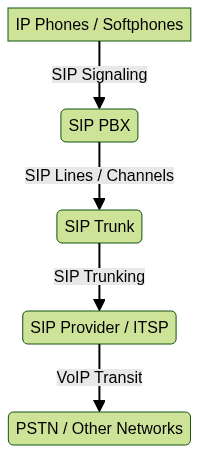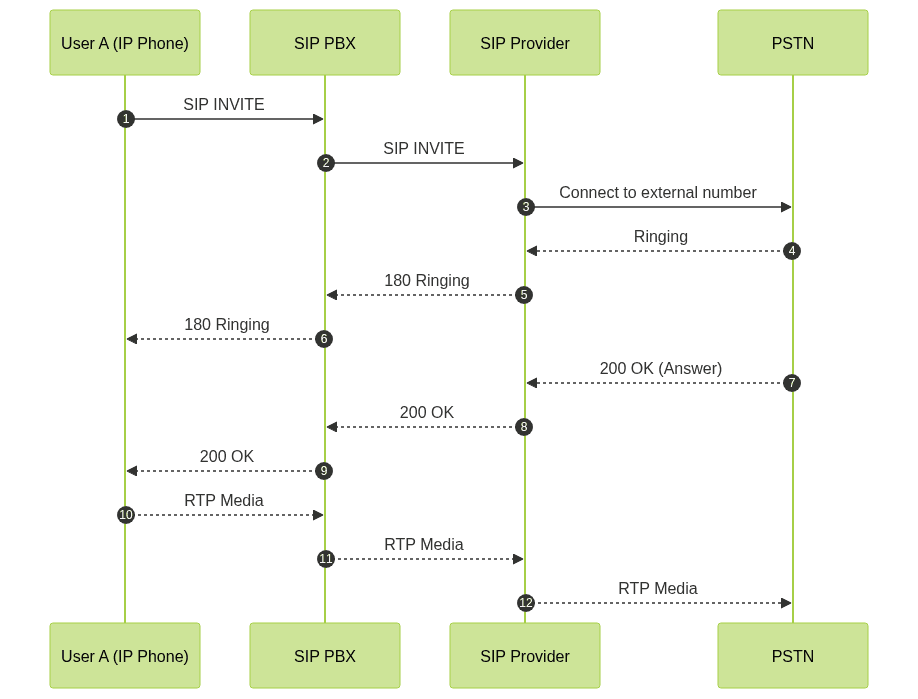SIP Lines: The Modern Solution for Business Communication
In today's rapidly evolving digital landscape, businesses are seeking smarter, more flexible, and cost-effective ways to communicate. Enter SIP lines \u2013 the backbone of modern Unified Communications (UC) and advanced VoIP telephony. As organizations in 2025 continue to decentralize and embrace remote work, SIP lines are quickly becoming the go-to solution for scalable, reliable, and feature-rich business phone systems. From enterprise PBX integrations to cloud telephony, SIP lines are redefining how companies handle voice, video, and messaging at scale.
What Are SIP Lines?
SIP lines, short for Session Initiation Protocol lines, are virtual communication channels that enable the transmission of voice, video, and messaging over IP networks. Unlike traditional phone lines that rely on the Public Switched Telephone Network (PSTN) and physical infrastructure, SIP lines use internet connectivity to establish and manage calls via VoIP (Voice over Internet Protocol).
A SIP line typically connects to a business's on-premises or cloud-based PBX (Private Branch Exchange), acting as a digital pathway for concurrent calls. Each SIP line can handle one active call session, but the real power lies in their scalability: businesses can easily add or remove SIP lines based on demand, avoiding the limitations of PRI (Primary Rate Interface) lines or analog circuits. For organizations looking to integrate advanced calling features, leveraging a
phone call api
can further enhance the flexibility and capabilities of SIP-based systems.SIP Line Architecture

This architecture streamlines communication, providing flexibility and cost savings that traditional phone systems can't match. Businesses can also benefit from integrating a
Video Calling API
to enable seamless video meetings alongside voice and messaging.SIP Lines vs SIP Trunks
While often used interchangeably, "SIP line" and "SIP trunk" represent distinct concepts. Think of a SIP trunk as a tree trunk, serving as the main conduit for communication between your PBX and the outside world. Each SIP line (or channel) is like a branch, representing a single call path that can be used for a voice, video, or messaging session.
For developers and IT teams, implementing SIP lines can be complemented by using a robust
Voice SDK
to create custom voice experiences and integrate advanced audio features into business applications.SIP Lines vs SIP Trunks: Feature Comparison
| Feature | SIP Line | SIP Trunk |
|---|---|---|
| Definition | Single virtual call path (channel) | Aggregate of multiple SIP lines (channels) |
| Use Case | Handles one concurrent call | Connects PBX to provider; handles multiple |
| Scalability | Add/remove lines as needed | Add/remove trunks as needed |
| Analogy | Branch | Tree trunk |
| Implementation | PBX channel configuration | PBX external connection |
Example SIP Configuration
Below is a simplified example of configuring a SIP trunk and defining SIP lines (channels) in an Asterisk PBX:
1[general]
2disallow=all
3allow=ulaw
4
5[my-sip-trunk]
6type=peer
7host=sip.provider.com
8username=myuser
9secret=mypass
10context=from-trunk
11
12; Define max channels (SIP lines)
13maxchannels=10
14This configuration sets up a SIP trunk with a maximum of 10 concurrent SIP lines. If you're interested in integrating calling functionality into your applications, exploring a
phone call api
can provide additional flexibility and scalability.Key Benefits of SIP Lines for Businesses
Cost Savings
SIP lines eliminate the need for expensive physical circuits and long-distance charges. With pay-as-you-grow models, businesses only pay for the number of channels they use, resulting in significant cost savings compared to PRI lines or legacy PSTN services. For those building custom communication apps, utilizing a
phone call api
can further reduce costs and streamline deployment.Scalability and Flexibility
Adding more SIP lines is as simple as contacting your SIP provider \u2013 no new hardware or wiring needed. This makes SIP line solutions ideal for growing organizations, seasonal demand spikes, or companies with fluctuating call volumes. For businesses looking to add video capabilities, an
embed video calling sdk
allows you to quickly integrate video conferencing features into your workflow.Unified Communications
SIP lines enable a single platform for voice, video conferencing, instant messaging, and more. This streamlines workflows, improves collaboration, and supports remote work scenarios, all under one integrated business phone system. Leveraging a
Video Calling API
can help unify these communication channels for a seamless user experience.Reliability and Redundancy
Top SIP providers offer advanced failover routing, geo-redundant data centers, and proactive monitoring. This ensures high availability and business continuity, even in the face of network outages or hardware failures.
How SIP Lines Work: Technical Overview
Session Initiation Protocol (SIP) Explained
SIP is a signaling protocol that establishes, manages, and terminates communication sessions over IP networks. It defines how endpoints (like IP phones or softphones) initiate a call, negotiate codecs, and manage session parameters. Developers interested in building VoIP apps for iOS can benefit from following a
callkit tutorial
to integrate native calling features.PBX and SIP Line Integration
A SIP-enabled PBX acts as the hub, managing SIP lines and routing calls internally or externally. Integration involves registering the PBX with the SIP provider and configuring call routing logic based on business needs. For advanced voice features, integrating a
Voice SDK
can enhance the overall communication experience.Bandwidth Requirements
Each SIP line consumes a specific amount of bandwidth, depending on the codec used. For example, a G.711 call typically requires about 85-100 kbps per call (including overhead). Proper bandwidth planning ensures high call quality and avoids congestion.
Call Quality Considerations
Factors like jitter, packet loss, and latency can impact VoIP. Dedicated fiber connections, QoS (Quality of Service) configurations, and network monitoring are essential to maintain reliable, high-quality SIP line performance.
SIP Call Flow with SIP Lines

SIP Registration Example
1REGISTER sip:sip.provider.com SIP/2.0
2Via: SIP/2.0/UDP 203.0.113.5:5060;branch=z9hG4bK-524287-1---d6e8e1a3
3Max-Forwards: 70
4Contact: <sip:myuser@203.0.113.5:5060>
5To: <sip:myuser@sip.provider.com>
6From: <sip:myuser@sip.provider.com>;tag=123456
7Call-ID: abcdefg123456@203.0.113.5
8CSeq: 1 REGISTER
9Content-Length: 0
10Implementing SIP Lines: Step-by-Step Guide
- Assess Current Telephony Infrastructure: Audit existing PBX and PRI lines.
- Choose a SIP Provider: Select a provider that offers reliability, scalability, and competitive pricing.
- Configure PBX for SIP: Update PBX firmware if needed, create SIP trunk profiles, and define SIP channels.
- Port Phone Numbers: Work with your provider to port existing phone numbers to the SIP service.
- Test and Troubleshoot: Place test calls, monitor call quality, and verify failover and redundancy features.
Transitioning from PRI to SIP lines is a structured process that can be completed with minimal downtime, especially when working with experienced SIP providers. If you're ready to modernize your business communications,
Try it for free
and experience the benefits firsthand.Best Practices for Managing SIP Lines
- Ensuring Call Quality: Implement QoS on your network to prioritize SIP traffic and allocate sufficient bandwidth for peak concurrent calls.
- Security Considerations: Use strong authentication, TLS/SRTP for encryption, and firewall rules to protect against SIP fraud and unauthorized access.
- Monitoring and Reporting: Leverage PBX reporting tools and real-time SIP analytics to track usage, call quality, and detect anomalies early.
SIP Lines for Remote Work and Future-Proofing
SIP lines are a cornerstone of cloud telephony, supporting seamless remote work and business continuity. With SIP, employees can access business phone systems from anywhere in the world, using IP phones, softphones, or mobile apps. As businesses grow, SIP lines can be scaled instantly, ensuring that communication infrastructure never becomes a bottleneck. By integrating a
phone call api
, companies can further empower remote teams with reliable and feature-rich voice calling capabilities.Conclusion: Why SIP Lines Are the Future
SIP lines are transforming business communication by delivering flexibility, unified communications, and significant cost savings. As companies embrace digital transformation and remote work in 2025, SIP lines offer the scalability and reliability needed to stay ahead. Explore SIP solutions today to future-proof your organization's communication strategy.
Want to level-up your learning? Subscribe now
Subscribe to our newsletter for more tech based insights
FAQ